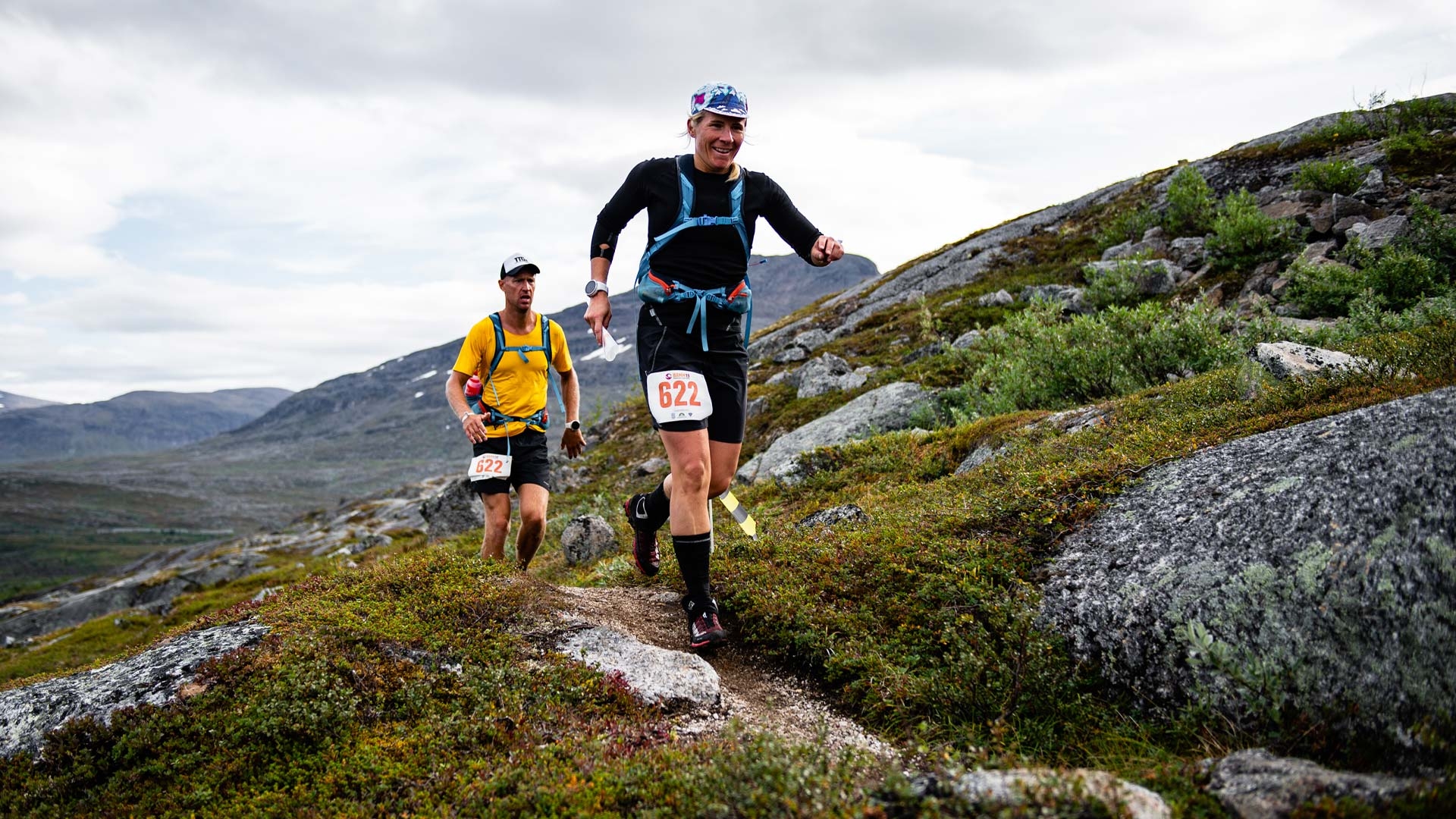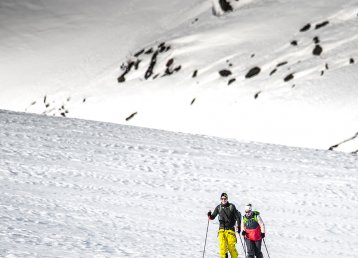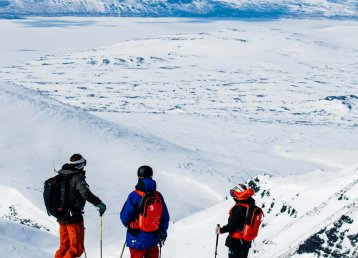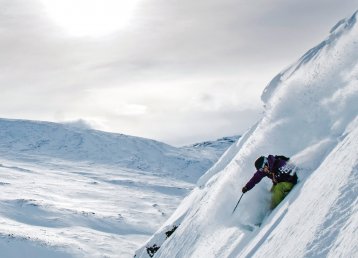“At least it gives you rosy cheeks”, Frida Lind Oja says, laughing. She says that her minimum temperature for the ski track is minus 20, sometimes a bit colder. She also says she is grateful that she never has a problem with it.
Frida is the marketing manager and co-owner of the family business Camp Ripan in Kiruna. It is a hotel with a difference, with a marketing manager who is also slightly different. This weekend she will participate in the Nordenskiöld race in Jokkmokk. She is looking forward to it. All 220 kilometres of it.
— Perhaps “looking forward to it” is not the right way to put it. But the challenge is fun, and so is knowing that I’m prepared enough to do that kind of race. I actually only got a spot in the race a couple of weeks ago. To say “yes” straight away, you need to have the basic training in place. It’s fun – even if it’ll be hard.
The basic training, in this case, is somewhere between 500 and 600 hours. Not all hotel owners, marketing managers and mothers-of-two can say they have it. When I ask her how many “kilometres on skis” she has done this year, she replies that she does not know. Then she says that her training diary is based on hours, with more than 500 hours recorded for this year.
— That many hours equal a fair few kilometres, naturally.
Kiruna
We are sitting in the lounge of Camp Ripan, a hotel in the centre of Kiruna. More than 30 kilometres of well-prepared, interconnected ski tracks are available here, starting right from the hotel entrance. In every way, this is absolutely ideal for elite exercisers like Frida, but also for her guests. The tracks in Kiruna are good training tracks for everyone, and once upon a time, this was where the best skiers in the world came to finish their season with the classic Kiruna Games. These days the World Cup circus and training are set up differently, so any hard races towards the end of April are less attractive to an exhausted top-level skier. But the tracks are still world-class, and above all, there is more comfort available to those who use them. It was back in 2002 that the family heard that the campsite was for sale. Frida was studying tourism science in Östersund, and Dennis, her brother, was playing ice hockey in the south of Sweden. One day, their mum Monica called and said she was interested in buying Ripan. The parents, Monica and Ove, used to run a restaurant in Kiruna – a natural way for Frida and Dennis to get their first taste of the hospitality industry. But when their parents separated, the restaurant closed. Now Monica said that both parents would consider investing in Ripan, but only if their children were also interested.
— For me, it was ideal: I was studying tourism science and could use Ripan as a ‘case study’ in everything I did. It might not have been as obvious for Dennis. But we said yes, so mum and dad took over, and we got to tag along.
Camp Ripan
In 2002 Camp Ripan was not what it is today. The cabins needed renovation. It really only served Norwegian summer visitors and long-distance commuters in winter. It was hardly an all-year-round facility with an award-winning kitchen and spa.
— Our vision was always to make the winter season a feast for international visitors. Icehotel was established and world-famous. But there were few other options here in Kiruna. We understood that there would be a market.
— Our mum took the first course that LTU Business arranged in “Tourist facility form and function”. It affected the way we shaped what we do – it still does today.
In short, Camp Ripan’s story is based on a meeting between the three different cultures that have shaped today’s modern Kiruna: the Sámi culture, the Torne Valley culture and the settlers who arrived when the mine opened. Ripa is Swedish for ptarmigan. The Sámi name is giron, which is also the Sámi name for the town, Kiruna. It was a given name for the campsite that would become a hotel.
— It feels obvious now. But in 2002, it wasn’t that easy to start building and rebuilding a facility based on cultural storytelling. It was perfect, though, a guideline that has helped us stay on track all these years.
Walking to my room a couple of hours afterwards, I contemplate this meeting of cultures. The door of my hotel room is red. Red is the classic colour of Swedish houses, a by-product of the copper mine in Falun since the 17th century. The window on the door is shaped like a lávvu, the tent of nomadic Sámi. A broom leans against the door, as a typical sign from the Torne Valley. The broom says no one is at home but that the door is open as usual, so you are welcome to take what you need. Tiny, tiny signs that together make up a story. All of them based on a love for this place and its characteristics.
Stay at Camp Ripan
Camp Ripan in Kiruna is a family-owned company with accommodation, restaurant, spa and activities. It is open all year around.
Learn more about Camp Ripan at ripan.se.
Natural
Frida Lind-Oja is, as you have probably gathered, an elite exerciser. She is simply drawn to the mountain environment every day. But there are other things than snot, sweat and training that give her rosy cheeks. She has always been outside. Always loved being outdoors. Every weekend, when she was a child, the family would pack up and go out into the woods with the rest of the family: cousins, aunts and others.
— One of my strongest childhood memories is when we bought our first ark so that we could spend the weekends fishing, in any weather. Do you know what an ark is? It’s one of those tiny cabins on a snowmobile trailer that you pull behind you, like a tiny home for winter fishers.
— Yes, I know what an ark is, but I probably wouldn’t have guessed it would be one of your best childhood memories.
— It affected me a lot, catching my own fish for dad (the chef…) to cook. I was the only one of us siblings and cousins who took the hunting exam, so I’ve been out hunting with my grandfather all these years. It also matters. It’s natural and important.
When you visit Aurora Spa this afternoon, the face cream is a remnant of your morning coffee, made from coffee grounds. And the body peeling contains birch leaves we've picked ourselves.
Frida is not a vegetarian. She eats what the family have hunted or caught, but she eats more and more vegetarian food. She says it is a bit tricky with teenage daughters who still love traditional sausages, but she says that slowly, surely, her conviction is growing stronger. The choice of food, and – how to phrase it? – a more sustainable lifestyle is definitely related to her enjoying being outside. It also affects the company philosophy, of course. When they built a new kitchen at Camp Ripan, the obvious goal was to become one of the world’s more climate-smart restaurant kitchens. With modern and climate-smart refrigeration systems and an industrial composter that turns leftover food into soil in one day, and where recycling and restraint are the most important things for the new kitchen.
— It feels natural and like a good thing, taking this further as we develop our business. Of course, it’s important to have a composter turning leftovers into soil. But it’s even more important to avoid any food waste at all. How do you use and cook everything from an entire animal? It’s actually a more important question than us turning what the kitchen doesn’t want to work with into soil.
— It also means that we try to use local products more and more. When you visit Aurora Spa this afternoon, the face cream is a remnant of your morning coffee, made from coffee grounds. And the body peeling contains birch leaves we’ve picked ourselves. It’s possible to make these simple things while at the same time telling the story of who we really are.
Aurora Spa
In 2013 the family decided to build their now award-winning Aurora Spa. Many friends and acquaintances in the business advised them against it, saying it would just be an expense. But the family still felt it was the right thing to do, something that would make Kiruna’s image complete. And the family was right. The trend involving well-being travellers is what has increased the most in the industry during recent years. We all want to feel a little healthier and fresher, perhaps also a little younger? Among the products I am presented with as I enter, there are several that are made in-house. The face cream with coffee grounds, cocoa and field mustard oil. (The oil is from Kukkola, by the way, further down the Torne River.) They say coffee and cocoa tighten your skin and reduce wrinkles – a bit like how your morning coffee brings you to life – so I take a generous amount and rub it in properly. Then it says to leave the cream to work for ten minutes. I lean back on the magnetite bench and try to breathe. In many ways, this is the most difficult part of the spa ritual: relaxing and giving yourself time. Forgetting everything that caused those wrinkles in the first place. But once I have rewarded myself those ten minutes of self-created mindfulness, it is liberating. I wash the face mask off and stand under a bucket of ice-cold water, restarting the spa ritual. The shock of icy water is always ‘refreshing’. But the rest of the time I spend at Aurora Spa, I use the hot pool, the hot sauna, a warming foot bath – which is also a clever little foot massage – yet another sauna and a wonderfully hot shower. I leave the cold aside, even if it would certainly give me rosy cheeks.
The future
Aurora Spa won the World Luxury Spa Awards as Europe’s premier activity spa. I think that suits the owner family. When they built it, the choice of materials was obvious. The slate for the floors comes from the Cap of the North. The wall in the lounge is a neatly stacked woodpile like you will find outside most houses in the Torne Valley. The benches are made from magnetite, the very ore underneath the town. The waterfall you encounter as soon as you step down into the refreshing mountain stream, where your spa experience begins, was not included in the drawings in the beginning.
— Mum had been on holiday, checking out various spa facilities. When she came home, there was no turning back. Our spa had to have a cold mountain stream. Construction had already begun, and the builders said: “But we can’t, we’ve already laid the floor”. Things like that don’t affect mum, not when she’s made her mind up. They had to strip the floor and build the mountain stream. The stones for the waterfall were collected in the nearby area. It has to be like that to make it a story.
I ask Frida some questions about plans, about the future. Camp Ripan will be developed. A new training and padel tennis centre has just been completed down by the campsite. The soil from the kitchen composter would be worth more if it also produced its own vegetables, so a greenhouse near the Aurora Spa is high on the list as a place for visitors to step inside and experience the green.
— And personally speaking, I’m going to participate in the Nordenskiöld race this weekend. It’s also BAMM (Björkliden Arctic Mountain Marathon) again this year. The last time I ran BAMM was in the 50-km class. We had other commitments straight after, a time we couldn’t change, so we didn’t dare to sign up for the 70-km class. But it would be fun the enter the 70-km class again.
— This is almost the best time of the year in the mountains, so I’m going to be there as much as I can. You know, just skating around on the snow crust, kilometre after kilometre. There’s hardly anything better than that.
– So, to summarise, Frida says and pauses for a bit, I’m going to ski a bit, but then I’m going to start running again.
Then she smiles again, the smile of someone who can’t wait.
BAMM
Björkliden Arctic Mountain Marathon – or BAMM – is considered one of the most challenging things to do, with your running shoes on, in Sweden. Every Year the races are held in the rugged, yet beautiful, environments of Arctic Sweden. This is a brief hint on what to expect. Learn more about the race at bjorkliden.com.






























